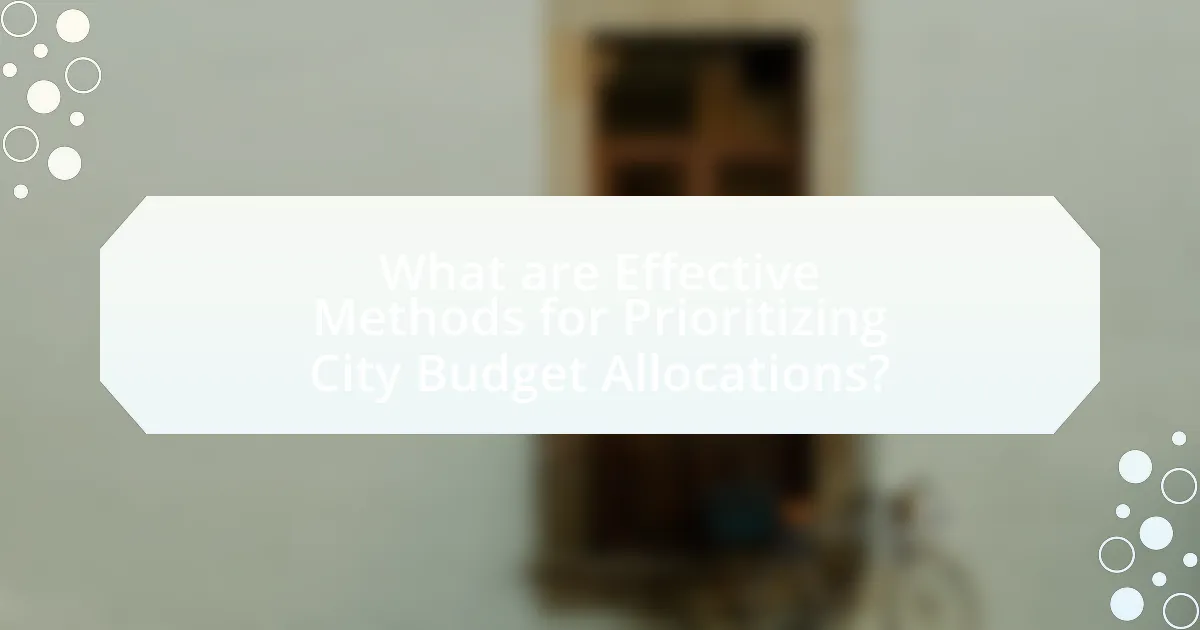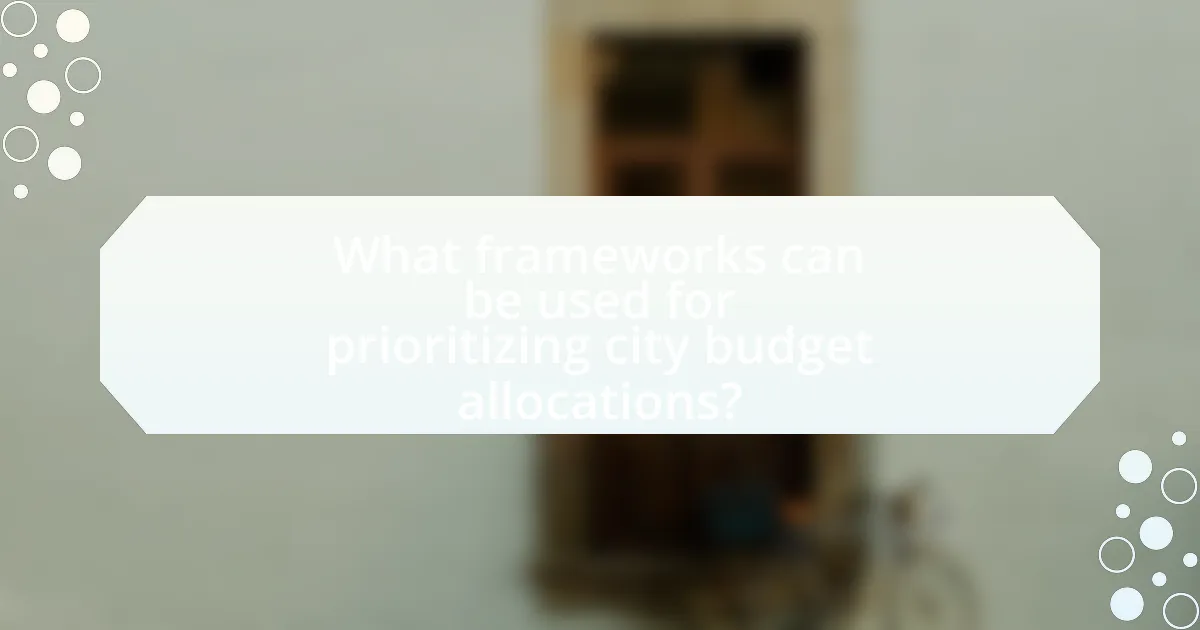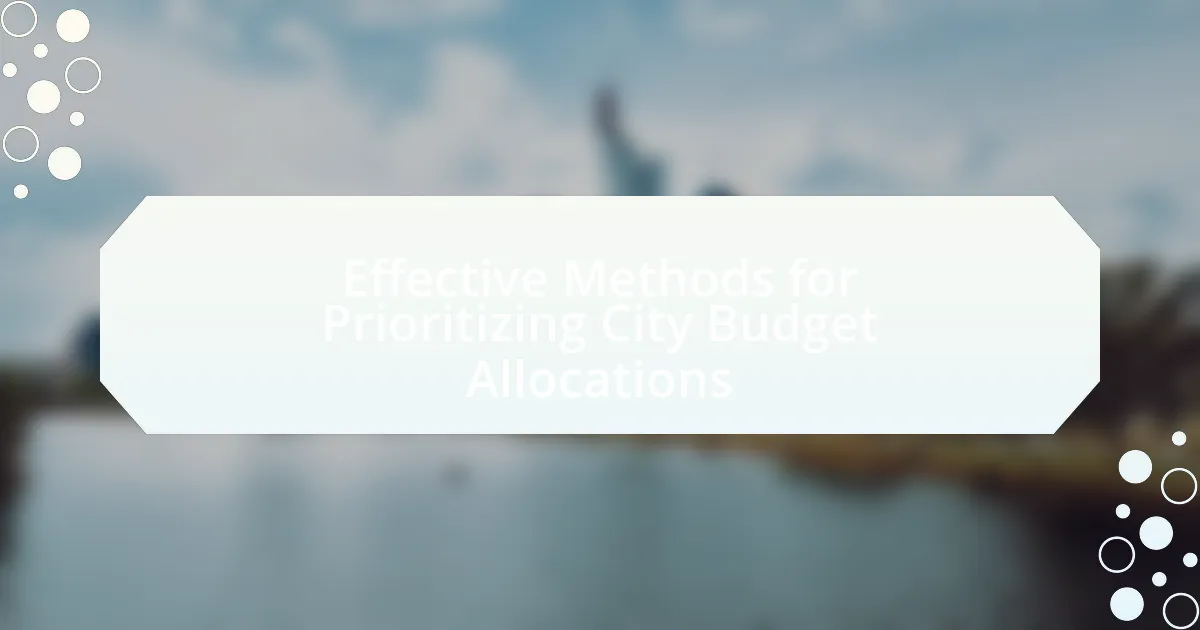The article focuses on effective methods for prioritizing city budget allocations, emphasizing data-driven decision-making, community engagement, and performance-based budgeting. It outlines how these methods enhance accountability and align budget allocations with community needs and strategic goals. The impact of budget allocations on community services, factors influencing their effectiveness, and the importance of prioritization are discussed. Additionally, the article explores frameworks like zero-based budgeting and performance-based budgeting, as well as tools and techniques that can improve the prioritization process, including stakeholder engagement strategies and data analytics.

What are Effective Methods for Prioritizing City Budget Allocations?
Effective methods for prioritizing city budget allocations include data-driven decision-making, community engagement, and performance-based budgeting. Data-driven decision-making utilizes quantitative metrics to assess needs and allocate resources efficiently, ensuring that funds are directed toward high-impact areas. Community engagement involves soliciting input from residents to identify priorities and enhance transparency, fostering trust in the budgeting process. Performance-based budgeting links funding to measurable outcomes, allowing cities to evaluate the effectiveness of programs and adjust allocations based on results. These methods collectively enhance accountability and ensure that budget allocations align with community needs and strategic goals.
How do city budget allocations impact community services?
City budget allocations significantly impact community services by determining the level of funding available for essential programs such as education, public safety, and health services. When a city allocates a larger portion of its budget to community services, it can enhance service delivery, improve infrastructure, and increase access to resources for residents. For instance, according to the National League of Cities, cities that prioritize funding for community services often see improved public health outcomes and reduced crime rates, demonstrating a direct correlation between budget allocations and community well-being. Conversely, insufficient budget allocations can lead to service cuts, reduced staffing, and diminished quality of services, negatively affecting the community’s overall quality of life.
What factors influence the effectiveness of budget allocations?
The effectiveness of budget allocations is influenced by several key factors, including alignment with strategic goals, stakeholder engagement, data-driven decision-making, and resource availability. Alignment with strategic goals ensures that budget allocations support the overarching objectives of the organization or city, enhancing their relevance and impact. Stakeholder engagement fosters transparency and accountability, allowing for diverse perspectives that can lead to more informed budget decisions. Data-driven decision-making relies on accurate and relevant data to prioritize funding based on needs and outcomes, which increases the likelihood of achieving desired results. Lastly, resource availability, including financial, human, and technological resources, directly affects the capacity to implement budget allocations effectively. These factors collectively contribute to the overall success of budget allocation processes in achieving intended outcomes.
How do community needs shape budget priorities?
Community needs directly influence budget priorities by guiding resource allocation towards essential services and programs that address specific local challenges. For instance, if a community identifies a high demand for affordable housing, local governments may prioritize funding for housing initiatives over other areas. This alignment ensures that budget decisions reflect the most pressing needs of residents, as evidenced by studies showing that cities with active community engagement in budget processes often see improved satisfaction and outcomes in public services.
Why is prioritization essential in city budget allocations?
Prioritization is essential in city budget allocations because it ensures that limited financial resources are directed towards the most critical needs and projects. By identifying and ranking priorities, city officials can allocate funds effectively to address pressing issues such as public safety, infrastructure maintenance, and community services. For instance, a study by the National League of Cities found that cities that prioritize budget allocations based on community needs experience improved service delivery and citizen satisfaction. This structured approach not only maximizes the impact of public spending but also fosters transparency and accountability in the budgeting process.
What are the consequences of poor budget prioritization?
Poor budget prioritization leads to inefficient allocation of resources, resulting in unmet community needs and project delays. When funds are not directed towards high-impact areas, essential services such as public safety, infrastructure maintenance, and education suffer, which can exacerbate social inequalities. For instance, a study by the Government Accountability Office found that cities with poorly prioritized budgets often face increased operational costs and reduced public trust, as citizens perceive a lack of accountability and responsiveness to their needs. This misalignment can ultimately hinder economic growth and community development, as critical investments are overlooked in favor of less impactful initiatives.
How can effective prioritization improve city governance?
Effective prioritization enhances city governance by ensuring that resources are allocated to the most critical needs and projects first. This strategic approach allows city officials to address pressing issues such as public safety, infrastructure maintenance, and community services more efficiently. For instance, cities that prioritize funding for essential services often experience improved public satisfaction and trust, as evidenced by studies showing that well-managed budget allocations lead to better service delivery and community engagement. By focusing on high-impact areas, city governance can become more responsive and accountable, ultimately fostering sustainable urban development.

What frameworks can be used for prioritizing city budget allocations?
Several frameworks can be used for prioritizing city budget allocations, including the Priority-Based Budgeting (PBB) framework, the Zero-Based Budgeting (ZBB) framework, and the Performance-Based Budgeting (PBB) framework. Priority-Based Budgeting focuses on aligning budget decisions with community priorities and strategic goals, ensuring that resources are allocated to the most critical services. Zero-Based Budgeting requires justifying all expenses from scratch for each budget cycle, promoting efficiency and cost-effectiveness. Performance-Based Budgeting links funding to measurable outcomes, allowing cities to allocate resources based on the effectiveness of programs. These frameworks are supported by various municipalities that have successfully implemented them, demonstrating their effectiveness in enhancing budget allocation processes.
How does the zero-based budgeting approach work?
Zero-based budgeting (ZBB) works by requiring all expenses to be justified for each new period, starting from a “zero base” rather than from the previous year’s budget. In this approach, every department must analyze its needs and justify its budget requests, ensuring that all expenditures align with current organizational goals and priorities. This method promotes efficient allocation of resources by eliminating unnecessary expenses and focusing on essential programs, as evidenced by its implementation in various organizations that have reported improved financial discipline and resource management.
What are the advantages of zero-based budgeting for cities?
Zero-based budgeting offers several advantages for cities, primarily enhancing resource allocation efficiency. This budgeting method requires city departments to justify their budget requests from scratch each period, promoting accountability and ensuring that funds are allocated based on current needs rather than historical spending patterns.
Additionally, zero-based budgeting encourages a thorough evaluation of all programs and services, allowing cities to identify and eliminate unnecessary expenditures. For instance, a study by the Government Accountability Office found that implementing zero-based budgeting can lead to significant cost savings, as it forces a critical assessment of all budget items.
Moreover, this approach fosters greater transparency and stakeholder engagement, as citizens can better understand how their tax dollars are being spent and can participate in the budgeting process. Overall, zero-based budgeting equips cities with a strategic tool to optimize their financial resources effectively.
What challenges might cities face when implementing zero-based budgeting?
Cities may face significant challenges when implementing zero-based budgeting, including resistance to change, resource intensiveness, and potential short-term disruptions. Resistance to change often arises from staff accustomed to traditional budgeting methods, leading to pushback against new processes. The resource intensiveness of zero-based budgeting requires substantial time and effort to evaluate every program and justify its existence, which can strain city staff and resources. Additionally, the potential for short-term disruptions can occur as departments adjust to the new budgeting framework, possibly impacting service delivery and operational efficiency during the transition period. These challenges highlight the complexities cities must navigate to successfully adopt zero-based budgeting.
What role does performance-based budgeting play in prioritization?
Performance-based budgeting plays a crucial role in prioritization by aligning funding with measurable outcomes and performance metrics. This approach enables city officials to allocate resources more effectively by focusing on programs that demonstrate tangible results, thereby ensuring that budget decisions are driven by data rather than arbitrary criteria. For instance, a study by the Government Accountability Office found that jurisdictions employing performance-based budgeting reported improved transparency and accountability in their financial management, leading to better prioritization of essential services.
How can performance metrics guide budget decisions?
Performance metrics can guide budget decisions by providing quantifiable data that reflects the effectiveness and efficiency of various programs and services. These metrics enable city officials to assess which initiatives yield the highest return on investment, thereby informing resource allocation. For instance, a city may analyze metrics such as service delivery times, citizen satisfaction ratings, and cost per service unit to identify underperforming areas. By prioritizing funding for programs that demonstrate strong performance metrics, cities can optimize their budgets to enhance overall service delivery and meet community needs more effectively.
What are the limitations of performance-based budgeting?
Performance-based budgeting has several limitations, including the difficulty in accurately measuring performance outcomes, which can lead to misallocation of resources. Many programs do not have clear, quantifiable metrics, making it challenging to assess their effectiveness. Additionally, performance-based budgeting can create a focus on short-term results at the expense of long-term goals, as agencies may prioritize easily measurable outcomes. Furthermore, the approach may inadvertently encourage gaming of the system, where agencies manipulate data to appear more successful than they are. Lastly, the implementation of performance-based budgeting requires significant time and resources for data collection and analysis, which can strain already limited budgets.

What tools and techniques can enhance the prioritization process?
Data-driven decision-making tools, such as cost-benefit analysis and prioritization matrices, can significantly enhance the prioritization process in city budget allocations. Cost-benefit analysis allows city officials to evaluate the financial implications of various projects, ensuring that resources are allocated to initiatives that provide the greatest return on investment. Prioritization matrices, on the other hand, help in systematically ranking projects based on criteria such as urgency, impact, and alignment with strategic goals. These techniques are supported by empirical evidence; for instance, a study by the National League of Cities found that cities employing structured prioritization methods reported a 30% increase in stakeholder satisfaction regarding budget decisions.
How can data analytics improve budget allocation decisions?
Data analytics can improve budget allocation decisions by providing data-driven insights that identify spending patterns and prioritize resource allocation effectively. By analyzing historical financial data, city officials can uncover trends in expenditures and revenues, allowing for more informed decisions on where to allocate funds. For instance, a study by the Government Accountability Office found that cities using data analytics for budget planning reported a 15% increase in budget efficiency. This demonstrates that leveraging data analytics not only enhances transparency but also optimizes the allocation process, ensuring that funds are directed toward the most impactful programs and services.
What types of data are most useful for budget prioritization?
Quantitative data, such as historical spending patterns, revenue forecasts, and demographic statistics, are most useful for budget prioritization. Historical spending patterns provide insights into past allocations and their outcomes, allowing for informed decisions on future funding. Revenue forecasts help in understanding the financial capacity of the city, while demographic statistics identify community needs and priorities. For instance, a study by the Government Finance Officers Association highlights that cities utilizing data analytics for budget decisions experience improved resource allocation and enhanced service delivery.
How can cities leverage technology for better budget insights?
Cities can leverage technology for better budget insights by implementing data analytics tools that provide real-time financial reporting and predictive modeling. These tools enable city officials to analyze spending patterns, forecast future budget needs, and identify areas for cost savings. For instance, cities like Los Angeles utilize platforms such as OpenGov, which allows for transparent budget tracking and performance metrics, leading to more informed decision-making. Additionally, integrating Geographic Information Systems (GIS) can help visualize budget allocations geographically, ensuring resources are distributed effectively based on community needs. This approach has been shown to enhance accountability and improve public trust in budget processes.
What stakeholder engagement strategies are effective in budget prioritization?
Effective stakeholder engagement strategies in budget prioritization include participatory budgeting, stakeholder workshops, and surveys. Participatory budgeting allows community members to directly influence budget decisions, fostering transparency and accountability. Stakeholder workshops facilitate dialogue among various interest groups, ensuring diverse perspectives are considered in the prioritization process. Surveys collect quantitative data on community preferences, providing a clear understanding of priorities. Research indicates that cities employing these strategies, such as Porto Alegre in Brazil, have seen increased public satisfaction and trust in government budgeting processes.
How can public input shape budget priorities?
Public input can significantly shape budget priorities by ensuring that the allocation of funds reflects the community’s needs and preferences. Engaging citizens through surveys, public forums, and participatory budgeting processes allows local governments to gather valuable insights on which services and projects are most important to residents. For instance, cities that have implemented participatory budgeting, such as Porto Alegre in Brazil, have seen increased public satisfaction and more equitable resource distribution, as residents directly influence spending decisions. This approach not only enhances transparency but also fosters a sense of ownership among community members, leading to more effective and responsive budgetary outcomes.
What methods can be used to facilitate stakeholder collaboration?
Methods to facilitate stakeholder collaboration include regular communication, collaborative decision-making processes, and the use of technology platforms for engagement. Regular communication ensures that all stakeholders are informed and can voice their opinions, which fosters transparency and trust. Collaborative decision-making processes, such as workshops or joint planning sessions, allow stakeholders to contribute to the decision-making, enhancing buy-in and commitment to outcomes. Technology platforms, like project management tools or online forums, facilitate ongoing dialogue and information sharing, making it easier for stakeholders to collaborate effectively. These methods have been shown to improve project outcomes and stakeholder satisfaction in various urban planning initiatives.
What best practices should cities follow for effective budget prioritization?
Cities should adopt a data-driven approach for effective budget prioritization. This involves utilizing quantitative metrics to assess community needs, such as crime rates, public health statistics, and infrastructure conditions. For instance, cities like San Francisco have implemented performance-based budgeting, which links funding to measurable outcomes, ensuring resources are allocated to programs that demonstrate effectiveness. Additionally, engaging stakeholders through public consultations allows cities to align budget priorities with community expectations, enhancing transparency and accountability. Research from the International City/County Management Association indicates that cities employing these practices experience improved fiscal health and citizen satisfaction.
How can cities ensure transparency in their budget processes?
Cities can ensure transparency in their budget processes by implementing open data initiatives that allow citizens to access budget information easily. This approach fosters accountability and encourages public participation in financial decision-making. For instance, cities like New York and San Francisco have adopted platforms that publish detailed budget data online, enabling residents to track expenditures and understand funding allocations. Research by the International Budget Partnership indicates that transparency in budget processes can lead to improved governance and increased public trust, as evidenced by higher citizen engagement in budget discussions and decision-making.
What common pitfalls should cities avoid in budget prioritization?
Cities should avoid the common pitfalls of neglecting community input, failing to align budgets with strategic goals, and prioritizing short-term gains over long-term sustainability. Neglecting community input can lead to misalignment with residents’ needs, resulting in decreased public trust and engagement. Failing to align budgets with strategic goals can cause inefficient resource allocation, undermining the effectiveness of city services. Prioritizing short-term gains can jeopardize future financial stability and the ability to address pressing issues, as evidenced by cities that have faced fiscal crises due to such practices.

Leave a Reply